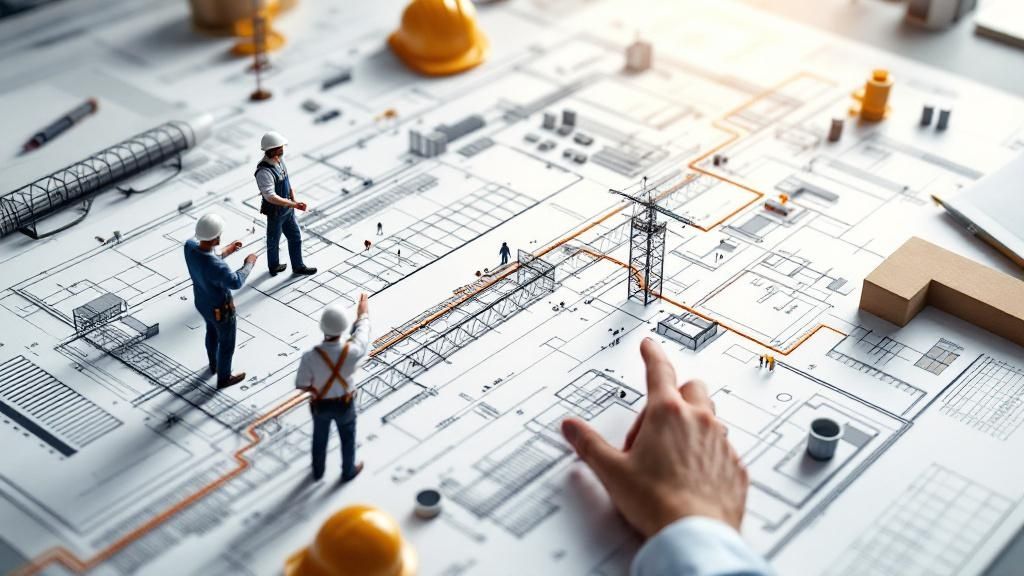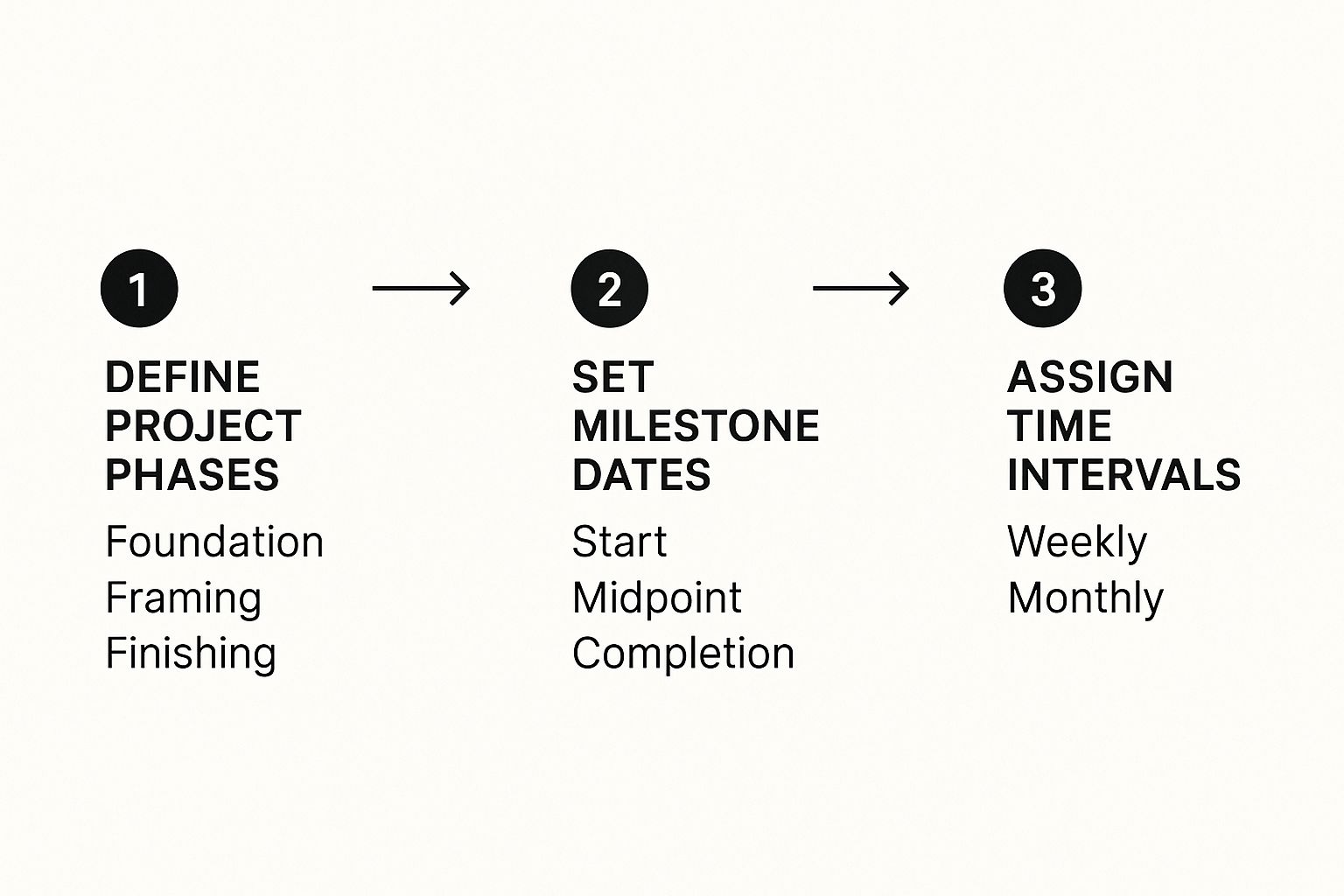In the high-stakes world of Bay Area construction, a project’s success is often decided long before a single nail is hammered. A solid construction project schedule is the real blueprint for that success—it's the dynamic roadmap that syncs up every trade, material delivery, and inspection with near-perfect precision.
Why Effective Construction Scheduling Is Non-Negotiable

Here in the Bay Area, a project schedule is much more than a simple calendar. It’s the operational nervous system of the entire job, dictating cash flow, managing client expectations, and ultimately determining profitability. Without a meticulously planned schedule, projects are wide open to risks, from painful budget overruns to damaging delays.
Construction projects are inherently complex, with countless moving parts. A well-crafted schedule brings essential order to that chaos, giving everyone on the job a clear path forward. For builders and contractors working in Berkeley, Oakland, and San Francisco, this level of planning isn't just a "nice-to-have"—it's a fundamental requirement for survival and growth.
A truly effective schedule is a comprehensive plan that accounts for all interconnected parts of a project. To build one, you must understand its core components.
Core Components of a Modern Construction Schedule
Here’s a breakdown of what a robust schedule should always include, especially when dealing with the unique challenges of building in the Bay Area.
| Component | Description & Bay Area Consideration |
|---|---|
| Work Breakdown Structure (WBS) | This breaks the entire project down into smaller, manageable tasks. For a Bay Area project, this means getting granular with phases like seismic retrofitting, Title 24 compliance checks, and specific local permit inspections. |
| Task Dependencies | This maps out which tasks must be completed before others can begin (e.g., foundation must be poured before framing starts). This is critical for sequencing trades correctly and avoiding costly downtime on-site. |
| Resource Allocation | Assigning the right people, equipment, and materials to each task. In our competitive market, this means confirming subcontractor availability months in advance and locking in key personnel for critical path activities. |
| Critical Path Method (CPM) | Identifying the longest sequence of dependent tasks that directly impacts the project's completion date. Any delay on the critical path means the whole project is delayed. This is your high-priority list. |
| Milestones | Marking major project achievements, such as "Foundation Complete" or "Building Watertight." These are essential for tracking progress, managing client expectations, and tying to payment schedules. |
| Timeline & Buffers | Setting realistic start and end dates for every task, including built-in time for potential delays. In the Bay Area, this means adding buffers for unpredictable weather, inspection backlogs, or traffic affecting deliveries. |
Having these elements in place transforms your schedule from a simple to-do list into a powerful management tool that can steer your project to a successful completion.
A Tool for Proactive Problem Solving
A great schedule does more than list tasks; it helps you see problems coming before they derail your progress. By mapping out every phase, you can spot potential bottlenecks, like coordinating foundation work and plumbing rough-ins, or timing window deliveries to match framing completion.
This foresight is absolutely essential in the Bay Area, where every project must navigate:
- Complex Permitting Processes: Each city, from San Francisco to the East Bay, has unique inspection quirks and timelines that must be baked into the schedule.
- Material Lead Times: Specialized materials, like custom windows, often have long lead times. That must be accounted for from day one.
- Subcontractor Availability: Demand for reliable trades is high. You must book the best crews well in advance, or you'll be left scrambling.
A common pitfall is an overly optimistic timeline. When you don't build in buffers for bad weather, inspection delays, or supply chain hiccups, you're creating a fragile plan just waiting to break. A realistic schedule is a resilient one.
Driving Efficiency and Profitability
A well-managed schedule is a direct driver of your bottom line. It's no secret that a significant number of construction projects experience budget overruns, and that is almost always tied back to poor scheduling and planning.
A detailed timeline helps optimize resource use. It ensures crews and equipment are on-site exactly when needed, not sitting around costing you money. It also provides a clearer picture for cash flow forecasting, as you can align payment draws with major project milestones.
This level of control prevents the costly ripple effect where one trade’s delay holds up three others down the line. That's how you protect your profit margins and build a reputation for bringing projects in on time and on budget.
Choosing Your Scheduling Method: CPM vs. Lean Construction

Picking the right way to schedule your project is a massive decision that shapes communication and defines how you tackle delays. The method you land on will clarify everyone's role on the job site.
In Bay Area construction, the conversation usually boils down to two main approaches: the traditional Critical Path Method (CPM) and the more collaborative world of Lean Construction. Each has strengths suited for different projects, and understanding their core differences is the first step to making a smart choice for your next build.
The Traditional Workhorse: The Critical Path Method
For decades, the Critical Path Method (CPM) has been the foundation of construction scheduling. It’s a logical, top-down system where you map out every task and its dependencies.
The “critical path” is the longest chain of these dependent tasks. Any delay to an activity on this path directly pushes back your final completion date. It’s a fantastic method for providing a clear roadmap, especially when the project scope is fixed and unlikely to change.
Imagine a large commercial build in downtown San Francisco. With its intense complexity and regulatory hurdles, CPM provides the rigid structure you need. It helps project managers:
- Pinpoint High-Priority Tasks: By focusing on the critical path, you know where to direct your attention to prevent derailments.
- Forecast Completion Dates: CPM gives you a data-driven timeline projection, which is invaluable for keeping clients informed and managing cash flow.
- Manage Resources Logically: It creates a clear framework for allocating labor and equipment based on a pre-planned sequence.
The Collaborative Approach: Lean Construction
Lean Construction, and specifically methods like the Last Planner® System, takes a different, bottom-up approach. The goal is to slash waste and create a reliable, predictable workflow through collaborative, short-term planning.
This "pull-planning" approach brings the people actually doing the work—the subcontractors and foremen—into the scheduling process. They make commitments about what can realistically be done in the coming weeks, which generates a much higher level of buy-in and accountability.
For a fast-moving residential remodel in Berkeley or Oakland, Lean principles can be a game-changer. The adaptive nature of Lean lets the team react quickly to on-site surprises or client change orders without blowing up the whole schedule. The core idea is simple: only plan in detail what you know for sure, reducing the risk of an unrealistic schedule.
Making the Right Choice for Your Project
The "best" scheduling method isn't one-size-fits-all; it depends on your project's context. A hybrid approach—using CPM for the high-level master plan and Lean principles for day-to-day execution—is often a powerful combination.
Here’s a quick comparison to help guide your decision:
| Factor | Critical Path Method (CPM) | Lean Construction |
|---|---|---|
| Project Type | Best for large, complex projects with a fixed scope. | Ideal for projects with potential for change, like remodels and custom builds. |
| Planning Style | Top-down, centrally planned by the project manager. | Bottom-up, collaborative planning with input from trades. |
| Flexibility | More rigid and less adaptable to frequent changes. | Highly flexible and designed to adapt to real-time conditions. |
| Team Culture | Relies on clear directives and following a master plan. | Fosters high levels of communication, trust, and team accountability. |
Ultimately, choosing your method is about matching the process to your project’s demands, your team's culture, and your client's goals. This will lead to more predictable outcomes and a smoother building experience.
Building Your Foundational Project Schedule
Let's get down to the brass tacks of building your initial schedule. This is where your high-level strategy gets broken down into a real, day-to-day plan of action.
A solid foundational schedule becomes the single source of truth for the entire job. It’s what you’ll use to track progress, manage crews and materials, and keep clients in the loop. We're moving from abstract goals to concrete tasks.
Deconstructing the Project with a Work Breakdown Structure
First, you need a Work Breakdown Structure (WBS). Think of it as a detailed, top-down to-do list for the entire project. You start with the finished product—say, a new Ipe deck—and break it down into major phases, and then into smaller, manageable tasks.
For a new deck project, a simple WBS might look like this:
- Phase 1: Permitting & Site Prep
- Submit plans to the Berkeley planning department.
- Clear and grade the site.
- Pour concrete footings.
- Phase 2: Framing & Decking
- Install ledger board and posts.
- Build the frame and joists.
- Install decking and stair stringers.
- Phase 3: Finishing & Final Inspection
- Install railings and stairs.
- Apply stain and sealant.
- Schedule and pass the final inspection.
The goal is to itemize every single activity, leaving no room for assumptions. Starting with an ultimate home remodel checklist can help ensure you don't miss obvious steps. This detail is essential for accurate time and cost estimates.
Estimating Durations with Bay Area Realism
Once you have your task list, you need to estimate how long each one will take. This is where experience pays off and where many schedules fall apart. Being overly optimistic is a surefire way to end up behind schedule and over budget.
Here in the Bay Area, you have to bake local realities into your estimates:
- Permitting Delays: Check the current backlog for the specific city, whether it’s Oakland or San Francisco, and add a 20-30% buffer to your timeline just to be safe.
- Seasonal Weather: Winter rains can bring excavation and concrete work to a halt. Build "weather days" into your schedule for any outdoor work planned between November and April.
- Material Lead Times: Custom windows or specialty lumber don't appear overnight. Confirm lead times with suppliers like Truitt & White before finalizing your schedule. This is especially true for jobs we cover in our deck planning guide and materials.
A realistic schedule anticipates hiccups. Always talk to your subs—they’re the ones doing the work and have the best feel for how long things really take.
Sequencing Tasks and Identifying the Critical Path
With tasks and durations sorted, you can put them in logical order by establishing dependencies. This sequence creates your project's timeline.

This process helps you identify the critical path—the longest chain of dependent tasks that sets the minimum time for the entire project. Any delay to a task on this path pushes back your completion date, so these activities need your closest attention.
Finally, you’ll assign labor, equipment, and materials to each task. This "resource-loaded" schedule gives you a complete picture of what happens, when, who, and what you need to make it happen.
Navigating Supply Chain and Material Delays

Even the most buttoned-up schedule can fall apart because of one late shipment. Actively managing your supply chain is as vital to construction project scheduling as laying out the tasks themselves. For any builder in the Bay Area, getting material management right is non-negotiable.
The market has thrown us all some serious curveballs. Recent years have seen construction input costs jump significantly, with wild price swings on essentials like lumber and steel. This volatility is a direct threat to your timeline and budget, making proactive management a necessity.
Your schedule can't be a static to-do list; it must be a living document built to absorb the shocks of material delays. You’re not just ordering supplies—you’re weaving procurement deep into your project plan.
Order Long-Lead Items Well in Advance
The simplest way to beat supply chain delays is to get way out in front of them. For any Bay Area build, you must pinpoint critical path items and get orders in months before you need them on site.
A few usual suspects come to mind:
- Custom Windows and Doors: Anything specialized can take many weeks or even months to arrive.
- Specialty Lumber and Siding: Custom-milled siding or specific grades of redwood aren't always in stock.
- High-End Fixtures and Appliances: Designer items often come with a significant lead time.
- Engineered Wood Products: Trusses and I-joists are almost always made to order.
Waiting until the walls are framed to order windows is a classic mistake. Placing orders during initial planning builds a crucial buffer into your schedule and helps lock in pricing, shielding your budget from surprises. We always tell clients to treat "Windows Ordered" as a critical activity with its own deadline.
Build Strong Relationships with Your Suppliers
In this climate, your relationship with your materials supplier is one of your most powerful tools. Building a genuine partnership with a trusted local supplier like Truitt & White gives you a safety net you can't put a price on.
A good supplier becomes an extension of your team. They provide ground-level intel, like early warnings on shortages or smart alternatives when a product is unavailable. That kind of transparency is the lifeblood of the construction process in San Francisco and the wider Bay Area.
This partnership also simplifies logistics. Coordinating delivery schedules means materials arrive just-in-time, keeping the job site clear and reducing the risk of theft or damage.
Weave in Contingency and Keep Communicating
Even with the best plans, things go wrong. A resilient schedule must account for material delays by identifying high-risk materials and having a "Plan B" ready. This might mean getting alternative products pre-approved by the client and architect.
Clear, constant communication holds this all together. Keeping your clients, subs, and suppliers in the loop manages everyone's expectations and fosters collaborative problem-solving. When your whole team is aware of supply chain risks, you can pivot together to keep the project moving forward, and staying on top of the latest advancements in construction machinery can also help.
The Human Element: Managing Your Team Effectively
A perfect digital schedule is worthless without the right team to execute it. Projects are built by people, and the human element—coordination, communication, and collaboration—brings a construction project scheduling document to life.
The industry is facing a chronic shortage of skilled workers. According to the Associated Builders and Contractors, the construction industry needs to attract an estimated 501,000 new workers in 2024 to meet demand. This massive gap directly contributes to project delays, making effective people management more critical than ever.
Mastering Subcontractor Coordination
For any contractor in the Bay Area, wrangling subcontractors is a high-stakes balancing act. The best trades are in constant demand, and booking them takes foresight and solid relationships.
Getting it right comes down to a few key actions:
- Talk early and often. Bring key subs into the planning process from the get-go. Their real-world experience is invaluable for realistic task durations.
- Set crystal-clear expectations. Ensure every sub has a defined scope of work, knows handoff procedures, and can access all project documents.
- Get ahead of conflicts. When multiple trades are in the same area, your schedule must be the final word on who goes when to prevent clashes and downtime.
A schedule should be a tool for collaboration, not blame. When subs feel they were part of the planning, their commitment to hitting dates skyrockets.
Running Productive Look-Ahead Meetings
One of the most powerful tools for keeping your team aligned is the weekly look-ahead meeting. This is a focused, tactical huddle to review the next two or three weeks on the schedule.
The goal is to spot and squash potential roadblocks before they cause a delay. In these meetings, you should confirm material readiness, verify crew availability, and ensure everyone is on the same page. It's also smart to loop in all partners, including services like construction site security, for a comprehensive plan.
This proactive approach transforms your schedule from a static document into a dynamic communication hub. It turns passive participants into active problem-solvers.
Cultivating Your Labor Pool
In a tight labor market like the Bay Area, you can't afford to be reactive. The best contractors forecast their labor needs months in advance. They cultivate a deep bench of reliable, local subcontractors by building long-term relationships based on mutual respect and paying on time.
When you need quality lumber in the East Bay for a framing crew, a strong network ensures you have the skilled labor ready to install it. Investing in the human side makes your project schedule more resilient and adaptive.
Leveraging Technology for Smarter Scheduling
Spreadsheets and paper calendars just don't cut it anymore. To stay competitive in the Bay Area construction scene, embracing modern technology is essential for survival. The right tools automate tedious tasks, enable real-time collaboration, and create a central hub for all project information.
Projects that adopt digital tools consistently have fewer delays and happier clients. For contractors working everywhere from Berkeley to Oakland, these platforms are the key to streamlining operations and gaining a serious competitive edge.
Choosing the Right Scheduling Software
The market for construction software can feel overwhelming. For huge commercial jobs, you'll often see big names like Oracle Primavera P6 or Microsoft Project.
But for most residential builders and remodelers, a better fit is usually a user-friendly, cloud-based platform like Buildertrend or CoConstruct. These integrate scheduling with other critical functions like client communication and financial tracking, simplifying your workflow.
The best software is the one your team will actually use. Focus on user-friendliness and its ability to solve your biggest headaches, whether that's subcontractor communication or material tracking.
Integrating BIM for 4D Scheduling
To elevate your scheduling, integrate it with Building Information Modeling (BIM). This creates 4D BIM, where you add time (the "fourth dimension") to your 3D model. You're no longer looking at a static blueprint; you're watching a dynamic simulation of the entire construction sequence.
This visual foresight is powerful for catching problems early.
- Clash Detection: Instantly see where an HVAC run will collide with a structural beam. It's a simple fix in the model but a costly mess on the job site.
- Logistics Planning: Visualizing the build sequence makes it easier to plan site logistics, like crane placement or material staging.
- Stakeholder Communication: A 4D model is the best tool for showing clients and stakeholders how the project will unfold, improving clarity and aligning expectations.
As Bay Area projects become more complex, 4D BIM provides foresight that Gantt charts can't match. It requires an investment in software and training, but the payoff in reduced rework and fewer delays is massive. Get the most out of these processes with the right gear, which you can learn about in our tool spotlight on elevating projects with top-tier equipment.
Frequently Asked Questions About Construction Scheduling
Here are answers to common questions we hear from builders, architects, and homeowners about construction project scheduling in the Bay Area.
What is the biggest mistake to avoid in construction scheduling?
The single biggest mistake is creating an overly optimistic schedule. A plan that doesn't build in buffers for real-world delays—like rainy weeks, slow permit approvals in Berkeley, or material shortages—is fragile and destined to fail, causing a cascade of problems and budget overruns.
How often should a construction schedule be updated?
A schedule is a living document, not a "set it and forget it" task. It should be formally reviewed weekly in coordination meetings and updated immediately whenever a significant change occurs. This ensures everyone is working off the most current information and maintains project momentum.
What does "schedule float" mean and why is it important?
Schedule float, or "slack," is the amount of time a task can be delayed without affecting subsequent tasks or the project's final completion date. Understanding float helps you prioritize: tasks with zero float are on the critical path and need close attention, while those with float offer more flexibility.
How can I reliably predict material lead times?
You cannot reliably predict lead times without direct communication. Always confirm lead times with your supplier for every key item, especially long-lead materials like custom windows, doors, and engineered wood. Build these confirmed timelines into your schedule from day one and order early to create a buffer.
What's the best way to handle unexpected delays on site?
The best approach is to communicate immediately with all stakeholders—the client, architect, and relevant subcontractors. Update the schedule to reflect the new reality, assess the impact on the critical path, and collaboratively decide on the best course of action to get back on track.
At Truitt & White, we know a successful project hinges on both a rock-solid schedule and the reliable materials to make it happen. For expert advice and a dependable supply chain partner for your next Bay Area build, connect with us or stop by our Berkeley showrooms.









